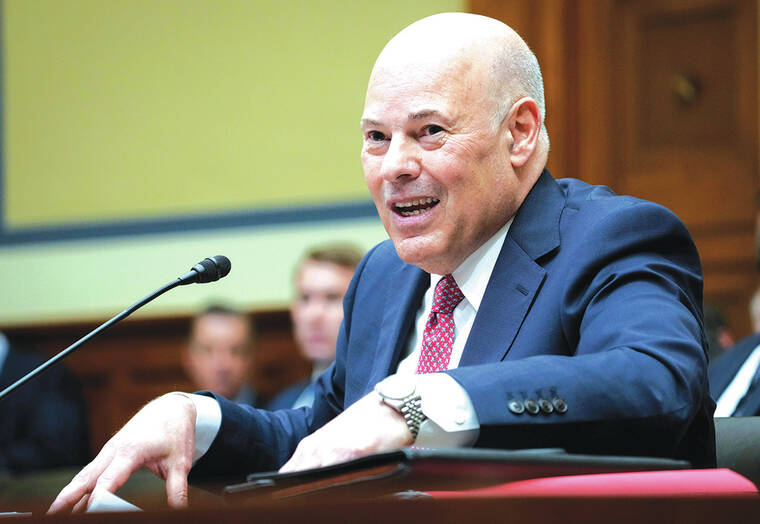Postal Service overhaul runs into challenges
WASHINGTON — More than three years ago, the U.S. Postal Service unveiled a sweeping 10-year plan meant to steer the organization out of a financial crisis. The plan, which included consolidating locations, raising prices and lengthening promised delivery times, was meant to stabilize an agency that had lost $87 billion over the past 14 years.
That effort has run into major obstacles. Early attempts to modernize the delivery network temporarily led to worse service in areas including Atlanta and Richmond, Virginia, where the agency has rolled out new regional processing and distribution centers.
ADVERTISING
The Postal Service’s long-term financial viability also remains in doubt. Revenue is up, but expenses have climbed, in large part because inflation has surged in recent years and driven up labor expenses. The agency has also called for administrative action that would adjust its pension costs, which has not occurred. At the same time, the Postal Service is grappling with declining mail volume.
In early 2021, Postal Service management initially projected that it would break even by fiscal year 2023. Instead, the agency, which is supposed to be self-sustaining, lost $6.5 billion that year and is projected to lose an additional $6.3 billion this fiscal year.
Lawmakers have pushed back on the changes, in part because of complaints about mail service in their districts. In May, a bipartisan group of 26 lawmakers sent a letter to the agency’s leaders expressing concern about the decline in on-time delivery in regions where there have been major changes. The lawmakers also called on the agency to pause changes to its processing network until its regulator fully studied their potential impact.
In response, Louis DeJoy, the postmaster general, said the agency would pause some of the changes until January and move forward with others that were underway.
In a lengthy interview, DeJoy defended the 10-year plan. He acknowledged that officials faced some initial challenges but said that the agency had long been in a “death spiral” and that he wanted to accelerate many of the changes. He also noted that service in the Atlanta and Richmond regions had substantially improved recently.
“Everybody wants to stop and do what?” DeJoy said of the requests to pause the changes. “Nobody has any other options for us.”
Sen. Gary Peters, chair of the Homeland Security and Governmental Affairs Committee, which oversees the Postal Service, said he was concerned that some of the changes had negatively affected service and had not significantly improved the agency’s financial condition.
“I believe that we need to have changes at the Postal Service,” said Peters, D-Mich. “But given the performance of some of the actions that have been taken so far, I think it’s important to have a pause and evaluate exactly what’s happening.”
Sen. Jon Ossoff, D-Ga., has also pressed the agency to “fully resolve disastrous performance failures,” which he said were affecting his constituents.
“I’m still hearing from Georgia families and businesses about the difficulty they continue to face sending and receiving their mail,” he said in a statement last month.
From April through June, the agency delivered 80.5% of single-piece first-class letters and postcards on time, which is the mail category that households use most often. That is down from 86.8% during the same period last year and below the agency’s current target of 92.3%, according to Postal Service data. On-time delivery has climbed to 84.3% as of the week ending Aug. 16.
In response to mounting pressure on Capitol Hill, DeJoy said he had “grown really numb” to criticism. “Who’s been more critiqued than me?” he said, adding that many of the concerns were “not credible.”
In 2020, his proposed changes led to an outcry from Democrats, who worried that they could slow the delivery of mail-in ballots before the election (that year, the Postal Service delivered 99.7% of ballots to election officials within five days, according to agency data). He was also scrutinized for his status as a longtime Republican donor and his ties to former President Donald Trump, who nominated DeJoy’s wife, Aldona Wos, to be the U.S. ambassador to Canada in 2020.
DeJoy said he was disappointed about the service declines and was “aggressively engaged” in correcting them. He cited long-standing “poor management practices” at the local level, issues with employee attendance and construction complexities at some locations as challenges.
Shortly after the processing center near Atlanta opened in February, on-time delivery of first-class mail in the area dropped below 60%, according to the agency’s data. Across the Georgia district, on-time delivery of first-class mail dropped as low as 35.8% in March. The Richmond region saw a similar decline in service after its processing center opened.
DeJoy said those issues had improved, and other areas such as Portland, Oregon, had more successful rollouts. In the Atlanta region, 84.9% of first-class mail was delivered on time as of the week ending Aug. 23, according to Postal Service data. In the Richmond region, 90% was delivered on time.
The postmaster general pointed to some financial successes: In 2022, Congress passed a major bill that ended a requirement that the agency fund retiree health care benefits in advance, a key goal in the 10-year plan. And the Postal Service has cut its projected 10-year losses to $65 billion from $160 billion.
DeJoy said the agency would have been close to breaking even last year, but high inflation substantially drove up costs and contributed to about $3 billion of the losses in fiscal year 2023. Another complication was that the break-even projection was predicated on administrative action that would have adjusted the agency’s pension costs, which has not yet happened. That contributed to another $3.1 billion in losses last year, he said.
“We got a tough start with the economy,” DeJoy said. “But we are working very hard. We’re adjusting.”
Still, he said it would probably take several years for the agency to stop losing money.
Although he acknowledged that mistakes could still happen, DeJoy said he expected the $40 billion overhaul to be smoother going forward. So far, the Postal Service has invested more than $15 billion to renovate facilities, install new equipment and upgrade 30-year-old technology and vehicles.
Some were more optimistic about the agency’s ability to make progress on its goals. Brian Renfroe, the president of the National Association of Letter Carriers, said that implementation had “pretty much gone as planned” and that it was too early to deem the plan a success or a failure.
“Modernization is so crucial right now,” Renfroe said. “The answer is not to do nothing.”
Others expressed more concern. Michael Kubayanda, chair of the Postal Regulatory Commission, said it was not yet clear whether service slowdowns in areas with new processing centers were simply an implementation issue or a problem with the plan’s design.
“We’re still in the early days, but so far the results have not been great,” he said.
The Postal Service’s inspector general has also issued a spate of reports in recent months scrutinizing the effects of the plan and the agency’s financial condition. During a congressional hearing in April, Tammy Hull, the inspector general, said a recent audit of the Richmond processing center found significant problems, in part because of “inadequate coordination with local management.”
Mark Dimondstein, the president of the American Postal Workers Union, which represents more than 200,000 Postal Service employees and retirees, said he understood there might be some growing pains, but the impact in areas like Atlanta was “absurd.” Although the Postal Service should slow its changes, he said, he thought some were necessary and he remained positive about the agency’s ability to shore up its finances.
“We remain very optimistic about the future of the post office,” Dimondstein said.
This article originally appeared in The New York Times.
© 2024 The New York Times Company




